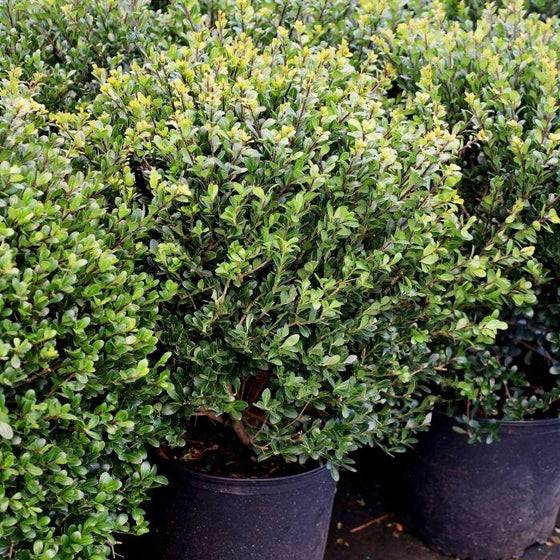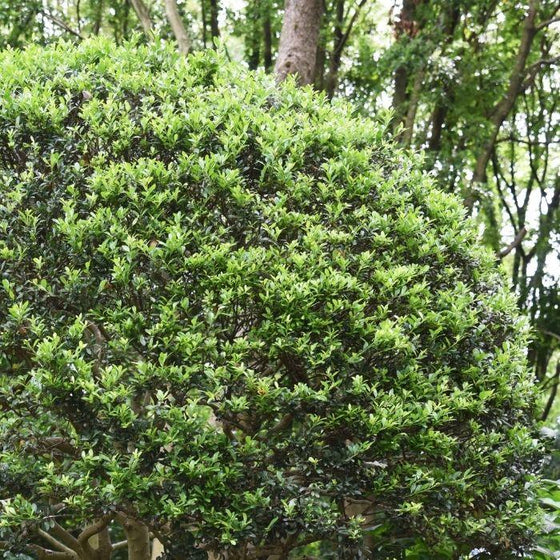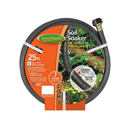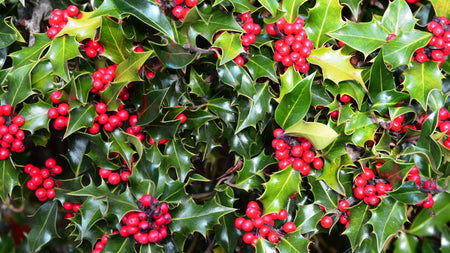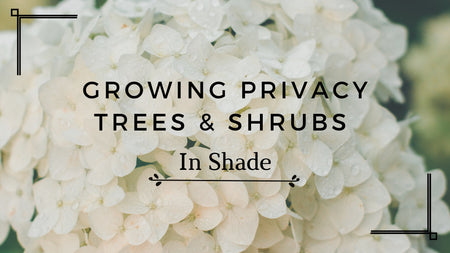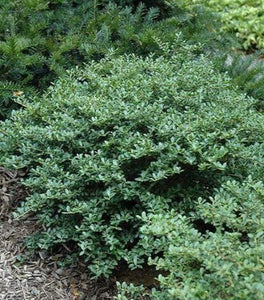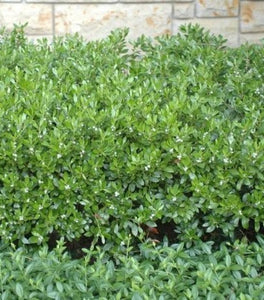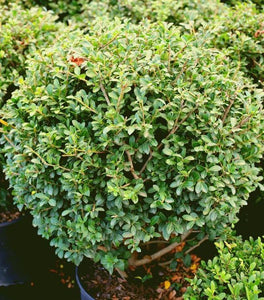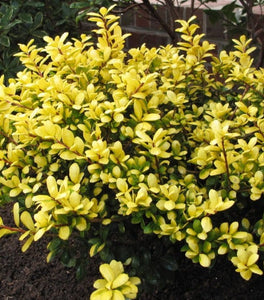
Images Depict Mature Plants
Compact Japanese Holly Shrubs
Compact Japanese Holly (Ilex crenata) is a versatile, low-growing evergreen shrub that features small, glossy, dark green leaves reminiscent of boxwoods, making it a popular substitute for boxwood in landscapes. Its dense, rounded growth habit and refined foliage provide an elegant and structured appearance, making it an excellent choice for borders, low hedges, and foundation plantings. Reaching a mature height of 4 to 5 feet with a similar spread, Compact Japanese Holly is ideal for adding a formal touch to garden beds or creating a lush green border.
Thriving in USDA zones 6-9, Compact Japanese Holly is highly adaptable to a range of growing conditions, including full sun to partial shade. It prefers moist, well-drained soil and demonstrates good drought tolerance once established. This holly variety is also prized for its low-maintenance nature, requiring minimal pruning to maintain its naturally rounded shape. Additionally, its small, inconspicuous white flowers in spring give way to small black berries in the fall, adding seasonal interest and attracting birds to your garden.
Compact Japanese Holly offers year-round beauty and structure with its dense foliage and tidy growth habit, whether used in mass plantings, as a neat hedge, or in mixed borders. Its resistance to pests and diseases and its ability to thrive in various soil types make it a reliable and easy-care choice for both formal and informal garden designs. With its attractive foliage and versatile growth habit, Compact Japanese Holly is perfect for creating timeless, well-manicured landscapes.

| Hardiness Zone: | 6-9 |
|---|---|
| Mature Height: | 4 to 5 Feet |
| Mature Width: | 4 to 5 Feet |
| Classification: | Broad leaved evergreen shrub |
| Sunlight: | Full sun |
| Habit: | Densely branched; mounding |
| Foliage: | Dark green |
| Flower Color: | White flowers that produce black berries |
| Pruning Season: | Prune in late spring to maintain shape |
| Soil Condition: | Any well drained soil |
| Water Requirements: | Water well until established |
| Uses: | Extremely attractive when used as in the mixed border, foundations, or planted in mass |
How to Care for Compact Japanese Holly
Be sure to read our planting instructions to ensure a healthy and happy Compact Japanese Holly for years to come!
How do I Plant Compact Japanese Holly Shrubs?
To plant Compact Japanese Holly shrubs, start by selecting a location with well-drained soil and full sun to partial shade for optimal growth. Begin by digging a hole twice as wide and as deep as the root ball to provide ample room for the roots to spread and establish. Place the shrub in the hole, ensuring the top of the root ball is level with or slightly above the surrounding soil to promote proper drainage. Backfill with a mix of native soil and compost to enhance soil structure and nutrient content. After planting, water thoroughly to help settle the soil and promote strong root development. When planting multiple Compact Japanese Holly shrubs for a hedge or border, space them about 2 to 3 feet apart, depending on the desired density. Mulch around the base of each shrub with a 2- to 3-inch layer of organic mulch to retain moisture and regulate soil temperature, being careful to keep the mulch a few inches away from the trunk to prevent rot. During the first growing season, water regularly to keep the soil consistently moist but not waterlogged. With proper planting and care, Compact Japanese Holly will establish quickly, providing a beautiful, low-maintenance evergreen addition to your landscape.
How do I Water Compact Japanese Holly Shrubs?
To properly water Compact Japanese Holly shrubs, focus on deep and consistent watering, especially during the first growing season to establish a healthy root system. Water the shrub deeply once a week, making sure the moisture reaches 6 to 8 inches into the soil to encourage deep root growth. During hot or dry periods, increase the frequency of watering to ensure the soil remains evenly moist, but avoid overwatering, as this holly prefers well-drained soil. It is best to water at the base of the plant and avoid wetting the foliage, as this can lead to fungal issues. Mulching around the base of the shrub helps to retain moisture and regulate soil temperature, reducing the need for frequent watering. Once Compact Japanese Holly is established, it becomes moderately drought-tolerant and will require less frequent watering. However, during prolonged dry spells or extreme heat, supplemental watering will help maintain the health and vibrancy of the shrub's glossy, dark green foliage. Check the soil regularly by digging a few inches down; if it feels dry, it's time to water. Proper watering practices will ensure that your Compact Japanese Holly thrives, providing dense, year-round greenery in your garden.
How do I Fertilize Compact Japanese Holly Shrubs?
To fertilize Compact Japanese Holly shrubs, apply a balanced, slow-release fertilizer in early spring, just before the growing season begins. A fertilizer with an N-P-K ratio around 10-10-10 is ideal for promoting healthy root development and vibrant, dense foliage. Spread the fertilizer evenly around the base of the shrub, being careful not to place it too close to the trunk to avoid root burn. After applying the fertilizer, water thoroughly to help the nutrients absorb into the soil and reach the root zone. This early feeding will provide the nutrients the holly needs to support strong growth throughout the season. For continued health and robust growth, Compact Japanese Holly shrubs can benefit from an additional light feeding in mid-summer, especially if they are planted in nutrient-poor soil. Incorporating organic compost or well-rotted manure around the base of the shrub is another effective way to enrich the soil and promote overall health. Regular fertilization not only keeps the foliage lush and green but also improves the plant's resistance to pests and diseases. With the proper nutrients, Compact Japanese Holly will thrive, providing a beautiful, low-maintenance evergreen feature in your garden all year round.

How do I Prune my Compact Japanese Holly Shrubs?
To prune Compact Japanese Holly shrubs, start by performing light pruning in late winter or early spring before new growth begins. This timing allows the plant to recover quickly and encourages dense, healthy foliage. Use clean, sharp pruning shears to remove any dead, damaged, or diseased branches to improve airflow and overall health. Trim the outer growth lightly to maintain the naturally rounded shape of the shrub, but avoid cutting back more than one-third of the plant at a time to minimize stress. This light pruning helps Compact Japanese Holly maintain its dense, compact form, making it ideal for low hedges or formal borders. For ongoing maintenance, Compact Japanese Holly shrubs may benefit from additional light pruning during the growing season, especially if used in formal designs that require a neatly manicured appearance. Avoid heavy pruning in late fall, as this can encourage new growth that may be damaged by winter frost. Thinning the interior branches occasionally helps to improve light penetration and prevent overcrowding, which reduces the risk of fungal issues. With regular pruning, your Compact Japanese Holly will retain its tidy, rounded form and provide year-round beauty and structure in your landscape.

